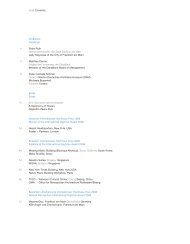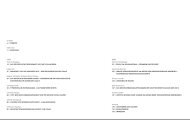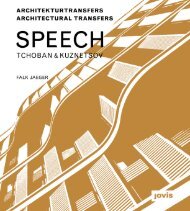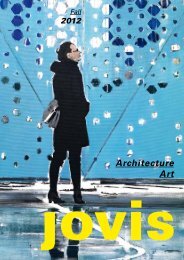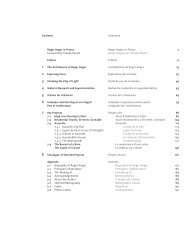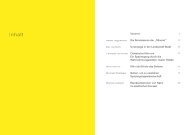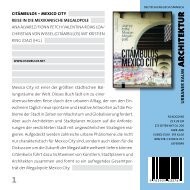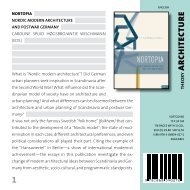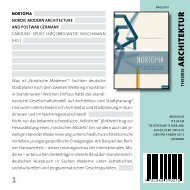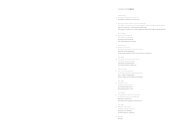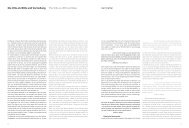Shrinking Cities 2 - JOVIS VERLAG Architektur Fotografie Berlin
Shrinking Cities 2 - JOVIS VERLAG Architektur Fotografie Berlin
Shrinking Cities 2 - JOVIS VERLAG Architektur Fotografie Berlin
Create successful ePaper yourself
Turn your PDF publications into a flip-book with our unique Google optimized e-Paper software.
Performative Architecture<br />
as the Basis of<br />
1<br />
the Performative Museum<br />
The analysis of performativity has been a staple in the GfZK program since<br />
2004. The term was first used in the context of the exhibition Performative<br />
Architecture, organized in collaboration with the Siemens Arts Program. 2<br />
The show was inspired by the construction of the GfZK’s new exhibition<br />
space in Leipzig by as-if berlinwien. Taking this “performative” building as<br />
a starting point, BLESS, Monica Bonvicini, Angela Bulloch, Oliver Hangl,<br />
Jeppe Hein, Olaf Nicolai, Anita Leisz, and Pro qm were invited to create work<br />
dealing with the relationship between architecture and performativity. Since<br />
then, performativity has been extended to incorporate the concept of the<br />
museum as well. Both the terms “performative architecture” and “performative<br />
museum” seem to evoke a double contradiction, as neither the static<br />
concepts of architecture nor the museum appear at first to correspond with<br />
the notion of performativity.<br />
According to John Langshaw Austin, a performative speech act is an act<br />
in which the speaker produces the thing (s)he names: I express myself by<br />
means of language and accomplish an action – because “saying makes it so.” 3<br />
Austin’s concept was later reformulated, amended, and extended – drawing<br />
into account the patterns, possibilities, and limitations of the functions of<br />
language; the contexts, social structures, and the respective competence of<br />
the speakers; the rituals and stereotyping to which performative utterances<br />
are subject; and finally in consideration of the consequences and effects of<br />
the reality-constituting power of language. In this context, gender study<br />
assumes special importance, investigating the relation between speech acts<br />
and identity constitution. 4<br />
In the 1960s, the term appeared in art in a modified form as performance<br />
and primarily denoted a unique event occurring within time limitations,<br />
frequently involving a situation-based ad hoc action: particularly in the<br />
western hemisphere, performances aimed to challenge the prioritization of<br />
the static esthetic object and the “commodification” of art, and demanded<br />
a change of production and reception conditions. 5 In turn, the “white<br />
cube” – as the predominant model of the exhibition display in the postwar<br />
era – became the focus of critical attention, and was, like the object too,<br />
forced to undergo temporalization. The exhibition space no longer acted as<br />
a representative repository for immovable values and attributes, but as a<br />
place for temporary and changing spatial proposals: the space transformed<br />
into an event venue, assuring unrepeatable experiences and encounters in<br />
the here and now.<br />
These developments affected the conception of museums: Willem<br />
Sandberg, director of the Stedelijk Museum in Amsterdam, even considered<br />
abandoning completely the old idea of the museum that holds a permanent<br />
collection. Seeking to render the museum more dynamic and acces-<br />
35<br />
Barbara Steiner<br />
1 Parts of this text have already been published<br />
in the essay “Performative Architecture” in:<br />
Angelika Nollert (ed.), Performative Installation,<br />
Cologne 2003, pp. 180–194<br />
2 Under the umbrella title Performative Installation,<br />
the Siemens Arts Program organized a<br />
five-part exhibition series, which took place<br />
in various institutions in Innsbruck, Cologne,<br />
Siegen, Vienna, and Leipzig. Different aspects<br />
of the central topic were dealt with in each<br />
respective location: Construction & Situation;<br />
Narrative; Communication; The Body &<br />
Economy; Architecture.<br />
3 Cf. John Langshaw Austin, How to Do Things<br />
with Words, Oxford 1962<br />
4 Judith Butler, “Performative Acts and Gender<br />
Constitution. An Essay in Phenomenology<br />
and Feminist Theory,” in: Sue-Ellen Case (ed.),<br />
Performing Feminism: Feminist Critical Theory and<br />
Theatre, Baltimore 1990, pp. 270–282; Judith<br />
Butler, Gender Trouble, New York/London 1990<br />
5 Concentrating on the artwork’s “material”<br />
substance was understood as an extension of<br />
capitalist logic and the need to overcome that<br />
logic. It was thus necessary to confront the<br />
autonomous esthetic object, seen as a crystallization<br />
of materialism, with a definition of<br />
work based on process. Cf. Robert Morris, “Anti<br />
Form” (1968) in: Continuous Project Altered Daily:<br />
The Writings of Robert Morris, Cambridge/London<br />
1993, p. 68



